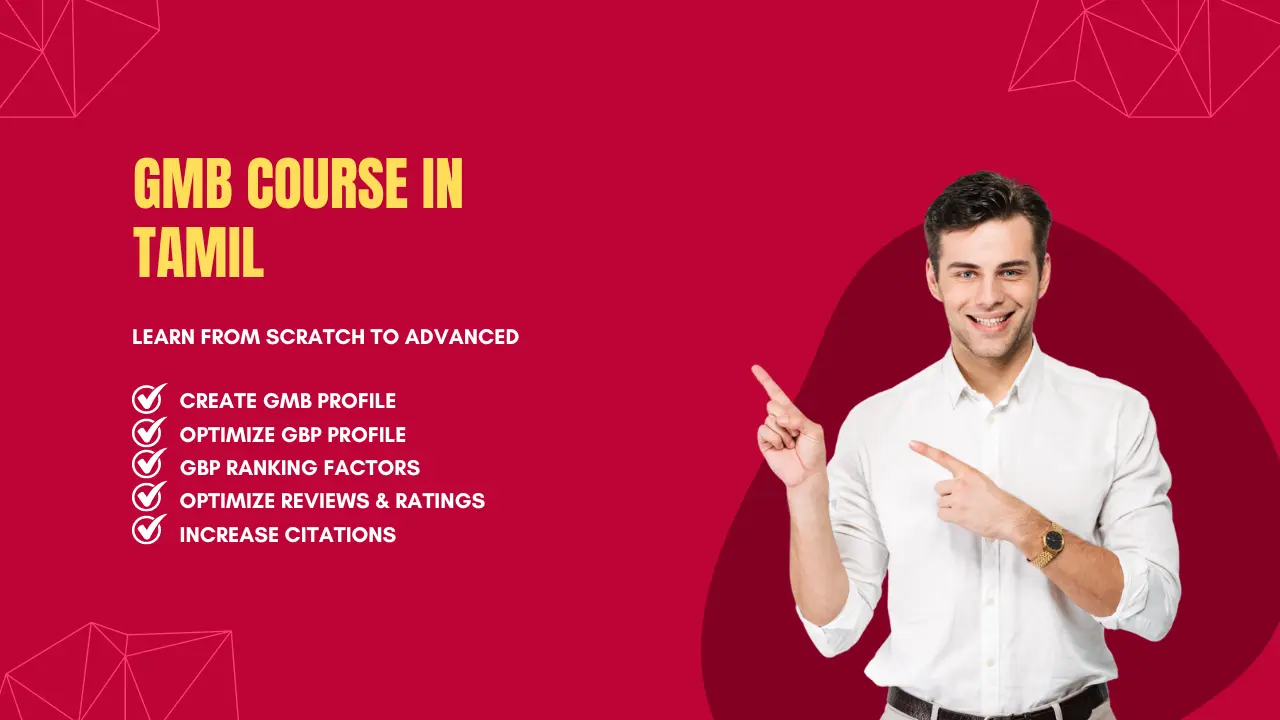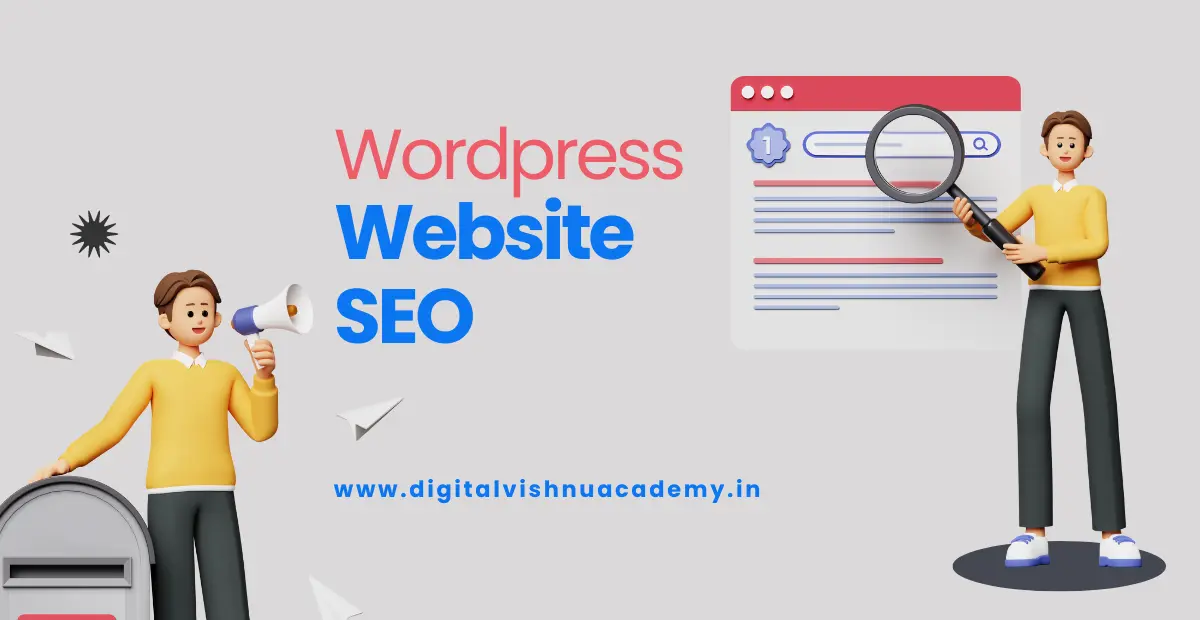Optimizing your WordPress website for search engines is important to get more visitors and improve your online presence. SEO (Search Engine Optimization) can seem complicated, but with the right tips, you can make your website more visible. This guide will explain WordPress website SEO in simple terms, using examples from digitalvishnuacademy.in
Introduction
SEO has changed a lot over the years. Old methods might not work anymore because search engines like Google update how they rank websites. For beginners, this is a good chance to learn the best current practices.
Whether you run a local business, an online store, or offer services, improving your website’s SEO can help more people find you. Let’s learn how to optimize your WordPress website step by step.
The Three Phases of WordPress Website SEO Optimization
To improve your website’s SEO, we’ll go through three main phases:
- Phase 1: Choosing Your Content and Topics
- Phase 2: Making Your Content Search-Friendly
- Phase 3: Keeping Your Website Updated
Phase 1: Choosing Your Content and Topics
1. Focus on Specific Categories
Tip 1: Start by focusing on specific topics instead of many different ones.
Why This Helps:
- It makes it easier for search engines to understand what your website is about.
- You can become an expert in a particular area.
- Visitors will find your website more organized.
Example with digitalvishnuacademy.in:
Digital Vishnu Academy focuses on teaching digital marketing. Instead of covering all technology topics, it concentrates on:
- SEO (Search Engine Optimization)
- Social Media Marketing
- Content Marketing
What You Can Do:
- Create Categories in WordPress:
- Log in to your WordPress dashboard.
- Go to Posts > Categories.
- Add categories that match your main topics.
- Plan Your Content:
- Decide how many articles you can write for each category.
- Aim to have at least 10 articles in a category before adding new ones.
2. Research Popular Topics
Tip 2: Choose topics that people are searching for and that fit your categories.
Why This Helps:
- Writing about popular topics brings more visitors.
- You can answer questions that people are actually asking.
Tools to Use:
- Google Trends: See what topics are trending.
- Keyword Planner: Find out how many people search for certain keywords.
- Ubersuggest: Get keyword ideas and see how hard it is to rank for them.
Example with digitalvishnuacademy.in:
If the academy wants to write about “Advanced SEO Techniques,” they should check if people are searching for this topic.
What You Can Do:
- Brainstorm Ideas:
- Think about what your audience wants to know.
- Make a list of possible topics.
- Check Search Volume:
- Use the tools to see how many people search for these topics.
- If a topic has low search volume, try finding similar topics with more interest.
- Use Related Keywords:
- Don’t focus only on one keyword.
- Include similar words and phrases to reach more people.
3. Check Out Your Competition
Tip 3: Avoid highly competitive keywords dominated by big websites.
Why This Helps:
- It’s hard to compete with well-established sites.
- Focusing on less competitive keywords gives you a better chance to rank higher.
Example with digitalvishnuacademy.in:
Instead of targeting “Best Digital Marketing Courses,” which is very competitive, they could try:
- “Digital Marketing Courses in [Your City]”
- “Beginner SEO Training for Small Businesses”
What You Can Do:
- Search Your Keywords:
- Type your chosen keywords into Google.
- See which websites appear on the first page.
- Assess the Competition:
- If big, well-known sites dominate the results, consider a different keyword.
- Look for keywords where smaller sites or forums rank well.
- Find Opportunities:
- Target keywords where sites like Quora or Reddit show up in results.
- These are often less competitive.
Phase 2: Making Your Content Search-Friendly
4. Use Posts for Articles
Tip 4: Use Posts (not Pages) for your regular articles.
Why This Helps:
- Posts can be categorized and tagged.
- They appear in your blog feed and are easier to organize.
Example with digitalvishnuacademy.in:
They use posts for articles like “Top SEO Tips” and pages for static content like “About Us” or “Contact.”
What You Can Do:
- When adding a new article, go to Posts > Add New.
- Assign the post to the right category and add tags.
5. Understand What Your Readers Want
Tip 5: Think about why people are searching for your topic and answer their questions.
Why This Helps:
- Your content will be more useful.
- Visitors are more likely to stay on your site and come back.
Example with digitalvishnuacademy.in:
If writing about “How to Start a Career in Digital Marketing,” they know readers want step-by-step guidance.
What You Can Do:
- Identify User Intent:
- Consider what problems your readers have.
- Think about the questions they might ask.
- Provide Clear Answers:
- Write content that directly addresses their needs.
- Include helpful tips and actionable advice.
6. Use Keywords Effectively
Tip 6: Include your main keyword in the first sentence or paragraph naturally.
Why This Helps:
- It tells search engines what your content is about.
- Helps readers know they’re in the right place.
Example:
“Starting a career in digital marketing can open many doors. In this guide, we’ll explore the steps you need to take.”
What You Can Do:
- Write an engaging introduction that includes your keyword.
- Make sure it sounds natural and not forced.
7. Give Clear Answers
Tip 7: Provide straightforward answers to common questions.
Why This Helps:
- Your content might appear in featured snippets (the answer boxes at the top of Google searches).
- Readers appreciate quick, clear information.
Example with digitalvishnuacademy.in:
Question: “What is SEO?”
Answer: “SEO stands for Search Engine Optimization. It’s the practice of improving your website to rank higher in search engine results.”
What You Can Do:
- Identify common questions in your topic.
- Answer them clearly right after the question or heading.
8. Organize with Headings
Tip 8: Use headings to structure your content:
- H1: Main title (used once per page)
- H2: Main sections
- H3: Subsections under H2
Why This Helps:
- Makes your content easier to read.
- Helps search engines understand the structure.
Example Structure:
- H1: “Guide to Digital Marketing”
- H2: “Understanding SEO”
- H3: “On-Page SEO”
- H3: “Off-Page SEO”
- H2: “Social Media Marketing”
- H3: “Building a Following”
- H3: “Engaging Content Ideas”
- H2: “Understanding SEO”
What You Can Do:
- Use headings to break up your content.
- Stick to one H1 per page.
9. Make It Easy to Read
Tip 9: Use short paragraphs and bullet points.
Why This Helps:
- Readers can digest information quickly.
- It keeps them engaged.
Example:
Instead of a long paragraph, write:
- Use relevant keywords.
- Optimize your images.
- Ensure your site loads quickly.
What You Can Do:
- Keep sentences and paragraphs short.
- Use lists where appropriate.
10. Add Images with Alt Text
Tip 10: Include relevant images and describe them using alt text.
Why This Helps:
- Images make your content more engaging.
- Alt text helps search engines understand the images.
- It’s important for accessibility (helps visually impaired users).
Example with digitalvishnuacademy.in:
They might include a screenshot of Google Analytics with alt text: “Screenshot of Google Analytics dashboard showing website traffic.”
What You Can Do:
- Add images that support your content.
- Write descriptive alt text for each image.
11. Link to Other Content
Internal Links:
Tip 11: Link to other articles on your site.
Why This Helps:
- Keeps readers on your site longer.
- Helps search engines understand your site’s structure.
Example:
In an article about “Social Media Tips,” link to another article on “Creating Engaging Content.”
External Links:
Tip 12: Link to reputable external websites.
Why This Helps:
- Provides extra value to your readers.
- Shows search engines that you’ve done your research.
What You Can Do:
- Find relevant articles on your site to link to.
- Link to trustworthy sources when mentioning facts or statistics.
12. Use SEO Plugins Like Rank Math
Tip 13: Install an SEO plugin to help optimize your content.
Why This Helps:
- Plugins provide suggestions to improve your SEO.
- They make technical aspects easier.
What You Can Do:
- Install Rank Math:
- Go to Plugins > Add New in WordPress.
- Search for “Rank Math” and install it.
- Optimize Your Content:
- Use the plugin’s analysis to improve your articles.
- Aim for a high SEO score by following its suggestions.
13. Use Content AI Tools
Tip 14: Use AI tools to get content suggestions.
Why This Helps:
- you include important keywords.
- Suggests questions and topics to cover.
Example with digitalvishnuacademy.in:
They can use Content AI to optimize an article on “Latest SEO Trends.”
What You Can Do:
- In Rank Math, click on Content AI.
- Enter your focus keyword and target country.
- Review and apply the suggestions.
14. Add a Table of Contents for Long Articles
Tip 15: For long posts, include a table of contents.
Why This Helps:
- Makes it easier for readers to navigate.
- Helps them find the information they’re looking for.
What You Can Do:
- Install a Plugin:
- Use a plugin like Easy Table of Contents.
- Configure It:
- Set it up to automatically add a table of contents to your posts.
15. Check Before Publishing
Tip 16: Preview your post to make sure it looks good on all devices.
Why This Helps:
- Ensures a good user experience.
- Prevents visitors from leaving due to poor formatting.
What You Can Do:
- Use the preview option in WordPress.
- Check how your post looks on desktop, tablet, and mobile.
16. Keep URLs Simple
Tip 17: Use short, descriptive URLs that include your main keyword.
Why This Helps:
- Easier for users to read and remember.
- Better for SEO.
Example:
Change from https://digitalvishnuacademy.in/2024/09/27/seo-tips-for-beginners to https://digitalvishnuacademy.in/seo-tips-for-beginners.
What You Can Do:
- Set Permalinks:
- Go to Settings > Permalinks.
- Choose Post name.
- Edit the URL Slug:
- Before publishing, edit the URL to remove unnecessary words.
Note: Avoid changing URLs after publishing, as it can affect your SEO.
Phase 3: Keeping Your Website Updated
17. Create and Submit a Sitemap
Tip 18: Use Rank Math to create a sitemap and submit it to Google.
Why This Helps:
- It helps search engines find and index your pages.
- Ensures all your content is discoverable.
What You Can Do:
- Enable Sitemap in Rank Math:
- Go to Rank Math > Sitemap Settings.
- Make sure sitemaps are enabled.
- Submit to Google:
- Get your sitemap URL (e.g.,
https://digitalvishnuacademy.in/sitemap_index.xml). - Go to Google Search Console.
- Submit your sitemap under the Sitemaps section.
- Get your sitemap URL (e.g.,
18. Update Your Content Regularly
Tip 19: Revisit old articles every few months.
Why This Helps:
- Keeps your content fresh and relevant.
- Improves your SEO rankings.
What You Can Do:
- Add new information or update outdated facts.
- Link to new articles you’ve published.
- Refresh images or examples.
Example with digitalvishnuacademy.in:
They might update an article on “SEO Trends for 2023” to include new trends for 2024.
19. Monitor Your Site’s Performance
Tip 20: Use Google Analytics to see how your pages are performing.
Why This Helps:
- Identifies pages that need improvement.
- It helps you understand your audience better.
What You Can Do:
- Check Engagement Metrics:
- Look at metrics like bounce rate and time on page.
- Optimize Underperforming Pages:
- Improve the content quality.
- Make sure the page loads quickly.
- Add images or videos to engage readers.
20. Refresh Important Pages Annually
Tip 21: Update your main pages at least once a year.
Why This Helps:
- Shows search engines that your site is active.
- Provides the latest information to your visitors.
What You Can Do:
- Review pages like “About Us,” “Services,” or cornerstone blog posts.
- Update any outdated information.
- Add new achievements or testimonials.
21. Build Strong Internal Links
Tip 22: Keep linking your pages together.
Why This Helps:
- Improves navigation for users.
- Helps search engines understand your site’s structure.
What You Can Do:
- Whenever you publish a new post, link it to older relevant posts.
- Use clear and descriptive anchor text (the clickable text in a link).
22. Don’t Change URLs After Publishing
Tip 23: Keep your URLs the same once your post is live.
Why This Helps:
- Changing URLs can break links and hurt your SEO.
- Keeps your site stable.
What You Can Do:
- Double-check your URL before publishing.
- If you must change it, set up a 301 redirect from the old URL to the new one.
Conclusion
By following these simple tips, you can improve your WordPress website’s SEO and attract more visitors. For a site like digitalvishnuacademy.in, these strategies help provide valuable information to people interested in digital marketing.
Remember, SEO is an ongoing process. Keep learning, stay updated with new trends, and regularly improve your website. With consistent effort, you’ll see your online presence grow.





 admin
admin 